Discover The Cauvery Wildlife Sanctuary The Wild Heart Of Karnataka
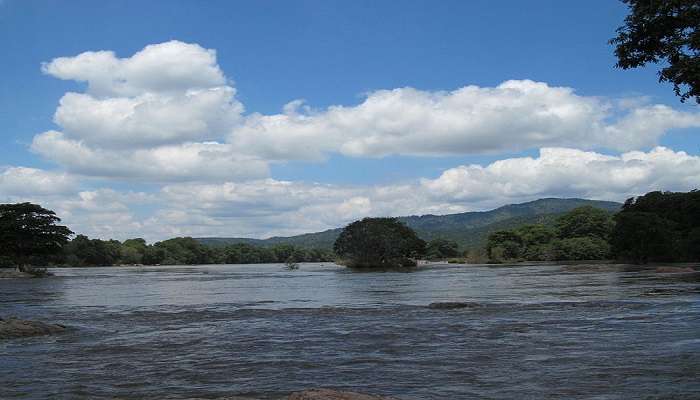
Located in the state of Karnataka within the region of the scenic Cauvery River, Cauvery Wildlife Sanctuary is a densely forested sanctuary famous amongst nature enthusiasts and adventure lovers. Cauvery Sanctuary is unique due to its proximity to the Cauvery River. The region has an outstanding variety of flora and fauna which is sure to fascinate every person regardless if you are bird watcher, wildlife photographer or a nature enthusiast who would like to have a close look at nature, Cauvery Wildlife Sanctuary has everything you’re looking for.
About Cauvery Wildlife Sanctuary
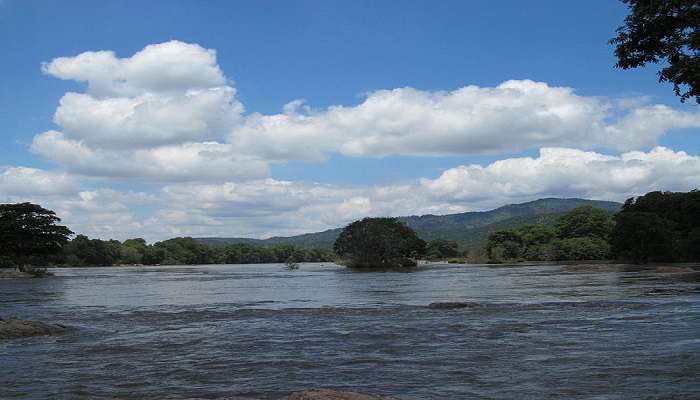
Cauvery Wildlife Sanctuary, established in 1987, covers an area of approximately 1,027 square kilometres. The sanctuary expands to Ramanagara, Chamarajanagar and Mandya districts in Karnataka. A name derived from the Cauvery River is given to the sanctuary because the river provides a lifeline for its rich biodiversity.
The sanctuary’s landscape consists of dry deciduous, riverine, and scrub forests, thus creating a diverse mosaic of habitats. This is also important as apart from being attractive, the Cauvery River, with its numerous tributaries and streams, provide permanent water sources for wildlife. It is an essential corridor for several migratory species and a significant conservation area in the Western Ghats biodiversity.
Must Read: Cotigao Wildlife Sanctuary
Entry Fee And Timings Of Cauvery Wildlife Sanctuary
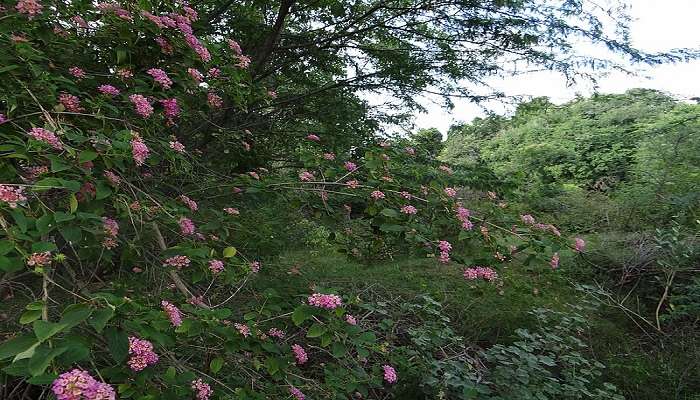
Tourists who want to access the Cauvery Wildlife Sanctuary must pay an entrance fee used in the sanctuary’s development and maintenance. The entry fee structure is as follows:
Indian Nationals: The estimated cost for this tour is INR 200 per person.
Foreign Nationals: ranging from INR 1000 per person.
Children (below 12 years): INR 100
Camera Charges: There might be an additional charge for still and video cameras.
The sanctuary is open to visitors daily from 9:30 AM to 5:30 PM. However, it is recommended that you stay informed about the timings and prices in case of any changes that might take place.
Flora And Fauna
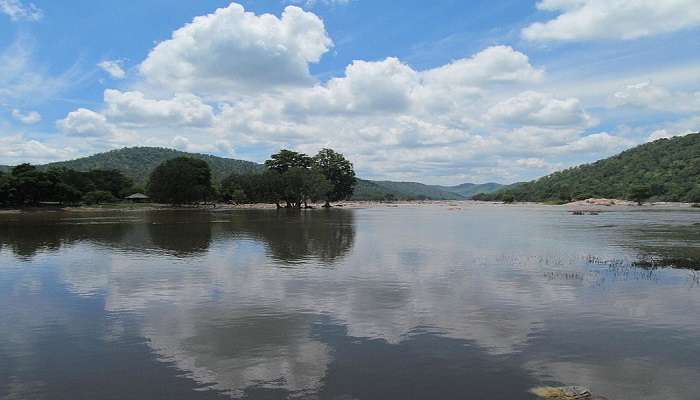
Flora:
The Cauvery Wildlife Sanctuary is home to a wide variety of plants consisting of mainly dry deciduous, riverine, and dry forests. Among the unique tree species, you will find teak (Tectona grandis), which is known for its durable wood; Sandalwood (Santalum album), prized for its aromatic heartwood; Bamboo (Dendrocalamus strictus), indicative of wildlife habitat and important food source; Indian gooseberry (Phyllanthus Emblica) which has been found to have medicinal properties and Terminalia (Terminalia arjuna) generally found on the banks of the river. The riverine forests are mainly lush, flourishing along Cauvery and rich in aquatic plants and trees.
Fauna:
The sanctuary is home to a variety of wildlife. Notable mammals include the Bengal tiger, Indian leopard, elephants, gaur (Indian bison), sloth bear, wild boar and the Sambar deer. Bird enthusiasts can spot more than 250 species, including the Crested Hawk Eagle, Indian Roller, White-bellied Drongo, Malabar Pied Hornbill and the endangered Great Hornbill. Different reptiles and amphibians like the Indian Rock Python, King Cobra and various frogs and crabs are also found in this region. The Cauvery is rich in aquatic life and is home to the highly endangered mahseer fish, turtles and otters.
Suggested Read: Resorts Near Agumbe
Things To Do

The Cauvery Wildlife Sanctuary offers a wide range of activities where visitors can immerse themselves in the beauty and tranquillity of nature:
Wildlife Safari: Embark on an exciting wildlife safari to explore the sanctuary’s diverse landscapes and discover the majestic wildlife. Guided safaris allow experienced naturalists to learn about flora and fauna.
Bird watching: The sanctuary is a bird watcher’s paradise due to its wide range of bird species. Bring binoculars and a camera for spectacular views of resident and migratory birds.
Hiking and nature walks: The sanctuary has many hiking trails and nature walks through its beautiful landscapes. These trails vary in difficulty and cater to beginners and experienced hikers.
Fishing: Cauvery is famous for its Mahseer fish, which attracts anglers from all over the world. Special fishing camps and permits are available for those willing to try their hand at this prized fish.
Boat rides and coracle rides: Another splendid activity is taking a boat ride or a coracle ride in the famous Cauvery River. Such activities offer opportunities to view the picturesque scenery of the sanctuary and to observe the fauna of the river’s bank.
Camping: Partake in the fun that comes with camping in the wild, especially within the sanctuary’s established camping sites. Being in the open with the only light of the fire and stars above is breathtaking.
Places To Visit Nearby
embark on your trip and immerse in the beauty of various species at this wildlife sanctuary. Also, don’t forget to explore the various attractions nearby, as mentioned below.
1. Mekedatu
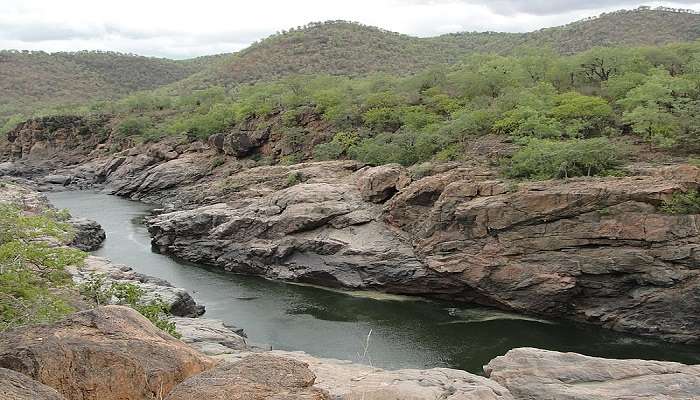
Mekedatu is a natural wonder, just 20 km from the Cauvery Wildlife Sanctuary, offering visitors a breathtaking experience. Mekedatu means “goat’s leap” which is a folk lore which tells about the story of a goat which leaped across the gorge to escape from a lion. The Cauvery River is famous for its thrilling course through a narrow valley with steep rocky cliffs. The river whirls through the gorge, creating a stunning backdrop for taking pictures and relaxing amid lush greenery. Riverbanks allow visitors to stroll, admire the scenery, or simply unwind in the stillness. Picnics are a popular pastime for families and friends, especially at Mekedatu, a picturesque spot with stunning views of the surrounding countryside.
Location: Kanakapura, Karnataka
Distance from Cauvery Wildlife Sanctuary: 38.3 KM
Suggested Read: Unchalli Falls
2. Bheemeshwari
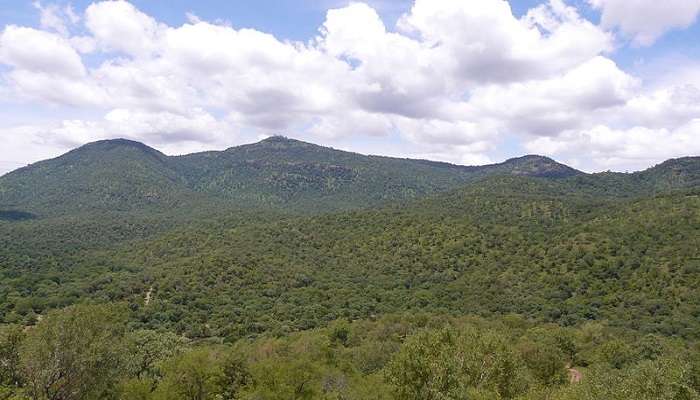
Bheemeshwari is an adventurous place in Cauvery Wildlife Sanctuary, which is 30 km away from the core area of the sanctuary and is famous amongst adventure travellers and enthusiasts. This place is filled with colourful and vibrant fishing villages. Here, fishing is widespread, and you can fish for the famous Mahseer fish, which is predominant within this area. There are numerous activities that people like to undertake, such as River rafting and trekking. Guided tours and nature walks are also provided, which gives you an insight into the diverse flora and fauna of the region. It is a must-visit place for all adventure lovers and tourists who are on the lookout for action-packed trips with scenic beauty.
Location: Bheemeshwari, Karnataka
Distance from Cauvery Wildlife Sanctuary: 234 KM
3. Shivanasamudra Falls
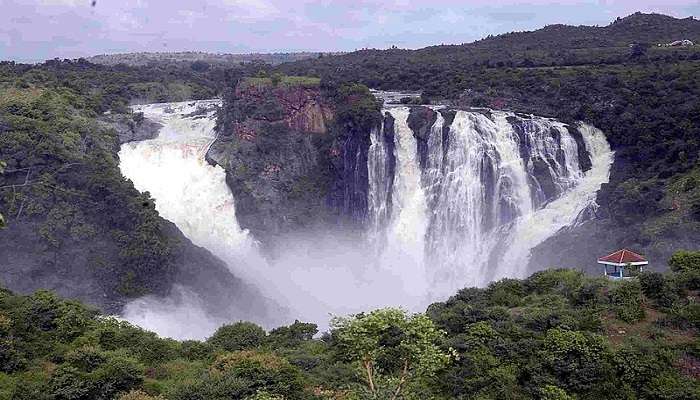
Shivanasamudra Falls is one of Karnataka’s most spectacular natural wonders; it is about 80 km from Cauvery Wildlife Sanctuary. This waterfall is further split into two parts, the Gaganachukki and the Barachukki. There is Gaganachukki, considered the northern part of the falls, which has spectacular water that is, on the one hand, powerful, and on the other hand, multiple falls. The Southern region has waterfalls, which are more tranquil as they are categorized as aesthetic. Shivanasamudra Falls is one of the most popular tourist destinations, filled with many viewpoints providing ample opportunities to capture stunning photos. This place is the perfect spot for people looking to relax, immerse themselves in nature, and need a break from the busy city life.
Location: Malavalli taluk, Mandya district, Karnataka, India and Kollegal taluk, Chamarajanagar district, Karnataka, India
Distance from Cauvery Wildlife Sanctuary;105.9 KM
Suggested Read: Temples In Halebidu
4. Hogenakkal Falls
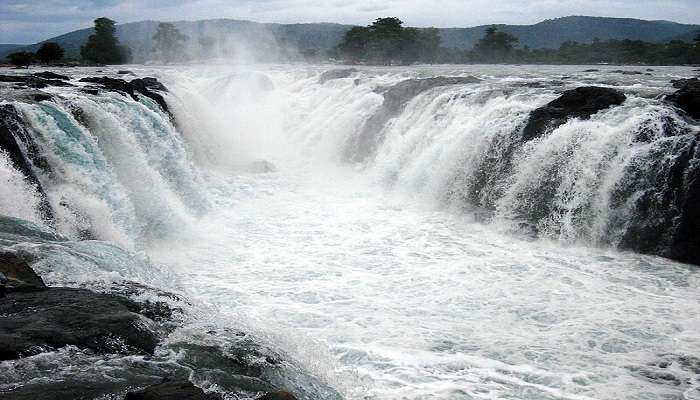
Some 100 km from Cauvery Wildlife Sanctuary is situated in Hogenakkal Falls, often called The Niagara of India, thanks to the cascades of the Cauvery River dropping from a height of over a hundred feet. Hogenakkal is a waterfall which lies in the southern part of India. Hogenakkal means “Smoking Rock” due to the mist created from the falls closely resembling white smoke. There are opportunities for coracle rides and rafting, which provide a beautiful view of the falls and their environment. The area also has many beautiful scenic spots that capture the beauty of the waterfalls. Hogenakkal is one of the best places to visit for nature, gorgeous sceneries, transparent water bodies, and breathtaking wildlife and local culture.
Location: Dharmapuri, Karnataka
Distance from Cauvery Wildlife Sanctuary: 12.8KM
Further Read: Kemmannugundi
The Cauvery Wildlife Sanctuary can be best described as nature’s preserve where one can find both – peace and thrill! Whenever you visit the sanctuary and the other complementary sites, ensure that you honour the environment and follow the rules and regulations set by the authorities. In doing this, you are supporting the preservation efforts to maintain this area as one of the most beautiful wilderness areas for generations. So bring out your luggage, slip on your trekking shoes and get set for a trip to Karnataka that will take you through Cauvery Wildlife Sanctuary.
For our editorial codes of conduct and copyright disclaimer, please click here.
Cover Image credit: By Jagadish Katkar for Wikimedia Commons.
Frequently Asked Questions About Cauvery Wildlife Sanctuary:
What is the best time to visit Cauvery Wildlife Sanctuary?
One should visit the Cauvery Wildlife Sanctuary from November to February. At this time of the year, the weather is pleasant and much suitable for outdoor activities and sightseeing.
How can I reach Cauvery Wildlife Sanctuary?
It is well connected to most of the places in Karnataka and the nearby states. One can reach by road from Bangalore or Mysore. The closest city is Bangalore which is at a distance of approximately one hundred kilometers.
Are there any accommodation options within the sanctuary?
Yes, it is possible to find some form of lodging within the sanctuary, even though there are only a few of them that include forest guesthouses and eco-camps. Pre-booking is advised.
What activities can I do at Cauvery Wildlife Sanctuary?
Tourism activities include wildlife and bird watching, fishing, trekking, and boat cruises across the Cauvery river.
Do I need permission to visit Cauvery Wildlife Sanctuary?
One needs to have a permit or permission to visit Cauvery Wildlife Sanctuary. There are compulsory charges that would be required for admission and other optional charges for cameral and guided tours.
People Also Read:
Pushpagiri Wildlife Sanctuary Bhagwan Mahavir Wildlife Sanctuary Wildlife Sanctuaries In West Bengal

Innovative Content Writer Focused on Producing High quality, Original Content that drives traffic and engages readers. Experienced in Content strategy and analytics to measure content performance using tools such as SQL, Power BI, Excel.











